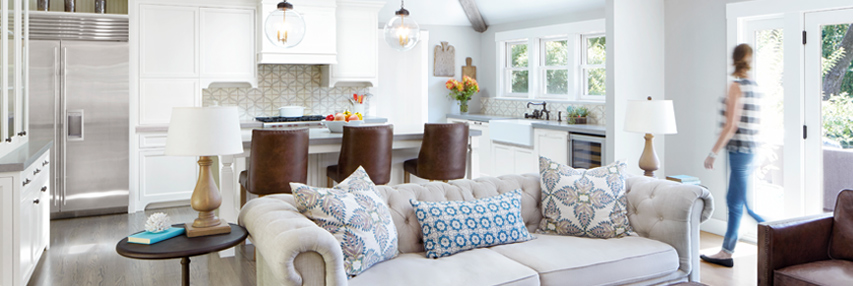The Realtor’s Guide to Getting Your Dream Home
If you believe some of today’s headlines, young professionals like you just aren’t interested in buying a home. You’re either too broke, too busy working, or too much of a nomad to plant roots in a community. But the numbers tell a different story.
In fact, millennials represented the largest share of homeowners, responsible for 35% of recent home purchases (via Realtor.org). No other generation showed as much buying power when it comes to real estate. Moreover, as a group, they have been gaining clout in each of the last four years.
How can you get into your dream home when housing markets are hitting new highs? We asked three millennial realtors, who are also homeowners, for advice on where and how to buy a first home. Read on for five tips they say will make you a smarter shopper.
1. Build a budget
Though you know you can probably afford a home—even one in a hot market—don’t overlook the importance of creating a budget before hitting the open houses. Ignore that, and it’ll be like trying to make a gourmet meal in your new Chef’s kitchen without first pulling and mixing the ingredients.
“A lot of people call a mortgage broker and find out they’re approved for $450,000. Soon enough, they’re out looking at $450,000 homes,” says Jim Streff, a Chicago-based SoFi member, who has been selling real estate in the Windy City since graduating from the University of Iowa in 2011 with a degree in finance. “They’ve got to consider the bigger picture —other financial goals—and then perhaps look at $300,000 homes instead.”
So, lay out your expenses before you start shopping: list your debt, recurring bills, everything you owe on a monthly basis. Now figure your total guaranteed monthly income. Finally, subtract your expenses from your income. Whatever remains is the amount you can afford on a monthly mortgage loan payment. But don’t plan to spend that much; leave wiggle room for unexpected expenses. Also think ahead about legal and closing costs, moving expenses, that funky mid-century living room collection you’ve been eyeing, and of course, your monthly savings goals.
2. Make a list of trade-offs
You want to buy a good home that fits your needs and increases in value over time. So once you’ve landed on a workable budget, decide what you’re willing to sacrifice, because, the truth is, you’re probably not going to find a house in your price range that provides all your needs.
Top 30 Under 30 Realtor Melissa Kennedy, who is based in Orange County, CA, suggests making a list of trade-offs—a top-10 list of features you want in a dream home—and sharing it with your realtor. Do you want to be in a gated community or a high-performing school district? You might want an upgraded kitchen and finished basement in your new home, but would you forego one of those things if the home is close to the downtown or public transportation? The more specific your list, the more likely it is a realtor will be able to show you a home that fits most of your criteria.
Recommended: 7 Ways to Make Buying a Home On Your Own a Reality
“Most of us can’t have it all in life, so it’s just a matter of finding something that works,” Kennedy says. “And you never know—a good agent can show you a home with features that aren’t on your list, but that you may love.”
3. Look for up-and-coming neighborhoods
Search in regions that will make you happy and support your target compensation and career ambitions. SoFi’s Quarterly Trends Report—Spotlight On Livable Cities will help you find affordable areas that support your talent and goals. For example, if you’re after a tech career, Denver may be a perfect spot and you won’t pay nearly what you would for a home in San Francisco or San Jose.
Once you’ve settled on a region, look to buy in an up-and-coming neighborhood. In south Florida, where SoFi member Mike Willinger has been selling homes for the past five years, areas once reserved for retirees are now attracting professionals and young families.
Doral in Miami, as well as Hollywood and Hallandale Park in Fort Lauderdale, are particularly attractive right now. “You’re going to get an older home for less money, because those neighborhoods were known as places where people’s grandparents lived,” Willinger says. “Location and price is attracting a lot of families, and smart budgeting helps those families make the move and still keep cash for upgrades.”
Streff’s budget-savvy young professional clientele are trading furnished apartments in the West Loop for homes in lower-cost Chicago neighborhoods, such as Jefferson Park, Avondale, and parts of Irving Park. And they’re doing it even when it means footing the bill for needed repairs after they’ve moved in.
The buying situation is a lot different in Orange County, CA, where it can cost upwards of $1 million for a home that needs to be gutted. “It can get pricey,” says Kennedy, who’s spent the last 14 years selling to clients in and around the region.
So to help young families find better options, she shows them homes in Irvine, and fixer-uppers in older areas, such as Nellie Gail Ranch in Laguna Hills. “These are great communities,” Kennedy says. “Demand is growing and there is a lot of potential to make money down the road.”
4. Research the property and the ‘hood
Your first home is also an investment that can pay off big over the long term. All three realtors we spoke with agree that it’s important to study both the property you’re eyeing and the neighborhood it’s in, because you can learn a lot by looking at historical price trends.
If you’re renovating an older property, pick a spot that has desirable attributes such as access to highways or public transportation. Resale value on these types of homes is higher, especially if you make noticeable improvements. Use our Home Project Value Estimator to get an idea of the return on your project.
Last year, Streff represented a contractor who remodeled a home in the Jefferson Park area of Chicago before selling. “He redid everything—the kitchen, bathrooms, heating, and air conditioning, top-to-bottom.” Streff says. “Just by rehabbing the right home in the right area, he was able to net roughly $80,000 in proceeds.”
Neighborhoods that are attracting new bars and restaurants usually include homes that are attractive to millennial professionals, and sometimes those homes need some work. A keen inspection can provide you with leverage when negotiating for an older home.
Related: How To Choose The Best Neighborhood When Buying a Home
“Say you find a place you like in Miami or Ft. Lauderdale but the air-conditioning unit is over 15 years old, and it would cost $10,000 to replace. You could ask the seller to either install a new A/C unit or knock $10K off the purchase price,” says Willinger. “Either way, just paying close attention might get you a better deal, allowing you to save money for fixes down the road.”
Streff agrees. “You don’t want to move in, have a furnace go out, and then be unable to afford a new one.” Pay attention to details when walking through a home you’re considering.
5. Think beyond a traditional mortgage
Raising the money for a down payment on a home can be tough on anyone. But for first-time homebuyers, especially those with student loans, it can be particularly difficult to raise the cash needed to put 20% down and avoid costly private mortgage insurance (PMI).
A better option may be to buy a condo in the right neighborhood using an interest-only loan to keep your monthly payment low. If you’ve bought well, you may be able to cash in the equity and trade up to a home in the area within a few years. “Clients who started with me years ago are now coming back, looking to move into bigger spaces,” says Streff.
Finding the right financing partner is key whether you’re buying for the first time or trading up. Take time to shop for the best deal and include alternative lenders such as SoFi. High-earning millennials looking to buy in markets best suited to their skills and potential can qualify for a mortgage loan, putting as little as 10% down on loans up to $3 million.
Your guide to a better buying experience
With the right financial strategy and a great realtor, you can buy the home of your dreams, regardless of whether it’s near the sleek beaches of Miami, the surf and sunsets of Newport Beach, or the regal bars and restaurants of Chicago’s Downtown Loop.
If you’re ready to get serious, let The SoFi Guide to First-Time Home Buying shows you the way. From choosing a lender to ordering inspections and preparing for closing, everything you need to know about the process of buying your first home is free to download right now.






Pingback: A Guide to How to Afford Your Dream Home » Aria Realty, Inc.